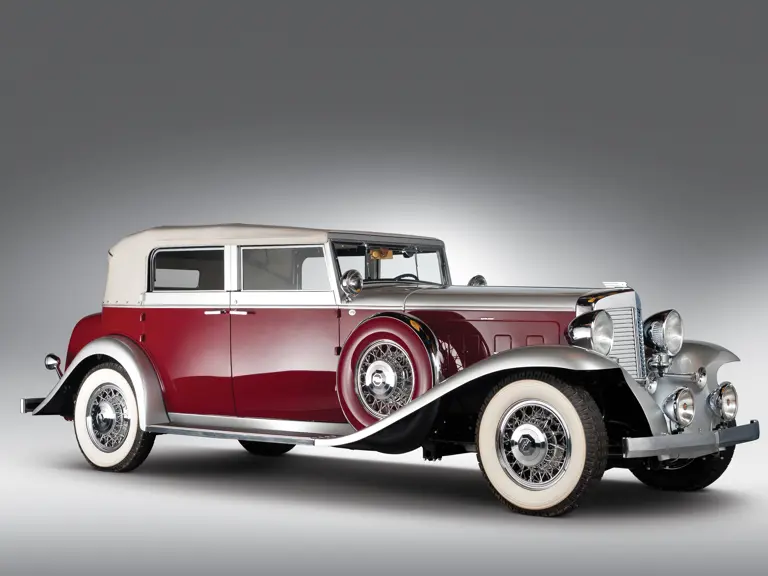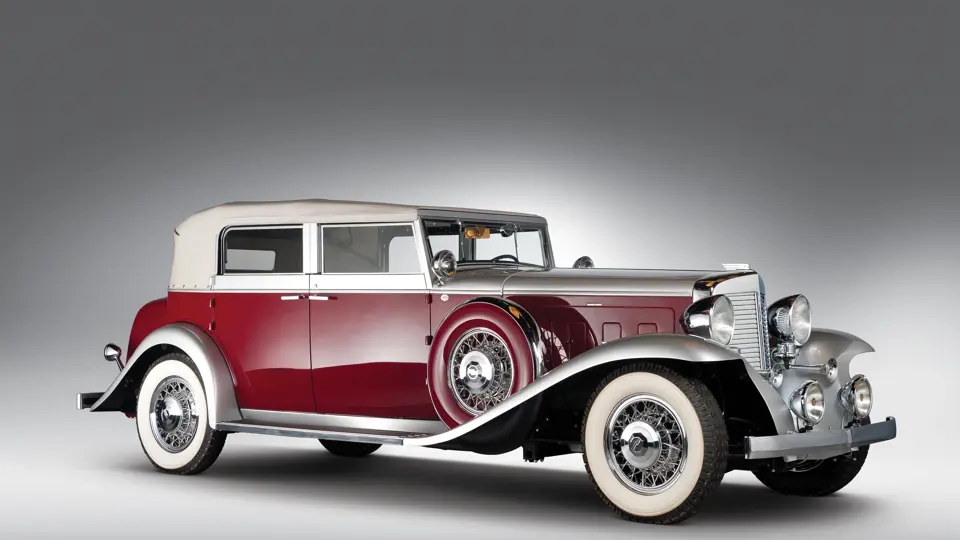Series 16. 200 bhp, 490.8 cu. in. overhead valve V-16 engine with three-speed manual transmission, solid front axle and live rear axle with semi-elliptic leaf springs, and four-wheel vacuum-assisted mechanical drum brakes. Wheelbase: 145"
• Rare surviving Sixteen with unbroken provenance
• Only four owners from new
• Matching-numbers engine and original body
• 100-point restoration
• CCCA Senior Badge 1439S
• Documented by Dyke W. Ridgley and Marmon Sixteen Roster
The winter of 1930-31 was a bittersweet time for Howard Marmon. His pièce de résistance, the Marmon Sixteen, had debuted to great acclaim at the Chicago Auto Salon in November, and the following month he received a medal for outstanding achievement from the Society of Automotive Engineers, awarded for the Sixteen’s magnificent engine. Although a second shift was added to the assembly line when full production began in April, there was trouble at the Marmon Motor Car Company. As with other luxury car makers, its profits had turned to deficits as the Depression deepened, and two rounds of pay cuts were followed by layoffs of most engineering staff. What had once been a bright future had become very, very uncertain.
Work on the Sixteen had begun in 1926. The heart of the new model was a compact even-firing 45-degree V-16 of 491 cubic inches. Overhead valves were pushrod-operated, and the aluminum block had wet cylinder liners. Its operation was so smooth that a light flywheel was possible, which in turn facilitated rapid acceleration. The valve gear was carefully designed to be compact and well lubricated, making it nearly silent, despite mechanical adjustment. The Sixteen developed 200 brake horsepower, rode a chassis of 145-inch wheelbase and was clothed in attractive Art Deco bodies.
Magnificent though it was, the Marmon Sixteen was not ready for production until early in 1931, by which time Cadillac’s V-16 had been on the market for over a year. Initial prices were as low as $5,200, $750 less than the equivalent Cadillac, but Cadillac had a head start and the advantage of a larger business base. The first Marmon Sixteen customer did not take delivery until April 1931. For the year, just over 200 Sixteens were produced, out of some 5,700 total sales. The total for 1932 was just 10 percent of 1,365 total cars, from which it seems odd that the eight-cylinder cars were discontinued entirely for 1933. It is not hard to understand, though, that with just 86 cars sold that year, about a third of which must have been leftover ’32s, Marmon was in receivership by the first of May.
This Marmon Sixteen is exceptional in that its history is known from new. According to Dyke W. Ridgley and the Marmon Sixteen Roster, it is one of 11 surviving Sixteen convertible sedans. Moreover, it is known to have its original engine and body and over its lifetime has been maintained in complete and operational condition, unlike many Classics that became derelict or were cannibalized when their market value hit bottom.
The car was originally sold in San Francisco to a Mr. Pantages, who owned a chain of theaters in California. Upon his death, the car was inherited by his chauffeur, a Mr. Storer, who used it in livery service for a few years. It was then retired to a garage in San Francisco until discovered by Robert D. Ford in 1956. Ford was able to buy it from the chauffeur, with some persistence, and used it himself for wedding hire. Although Ford spent much of his time in Venezuela, the car remained well-maintained in California, reported as an “original car in excellent condition” with 67,000 miles in 1982. It is safe to conclude, therefore, that this Marmon remained in California from new until the early 1980s, a total of six decades.
It was sold in 1983 to Michigan collector Marvin Tamaroff, who had Harry Sherry of Sherry Custom Autos in Warsaw, Ontario perform a comprehensive restoration in 1985. Having been brought to 100-point condition, it earned Best of Show honors at the CCCA Grand Classic meet at Detroit in 1989. The Milhous Collection acquired the car from Tamaroff in 1993.
Sherry’s 1985 restoration still presents extremely well. The car is striking in brilliant silver with mid-body in contrasting maroon. Body and paint are both excellent, as is the light grey canvas top. The interior is done in maroon leather, with matching carpet on the floor. The engine and chassis are superbly detailed, and the car rides on Denman 7.00x18 whitewall tires.
Imposing with its long trumpet horns, huge C.M. Hall Depress Beam headlamps, Trippe driving lights and dual Lorraine spotlights, it is certainly exceptional. With unbroken history and original engine and body, it is among the best of its small constituency of survivors. Marmon Sixteens rarely come to market, much less an example as outstanding as this.




 | Boca Raton, Florida
| Boca Raton, Florida


